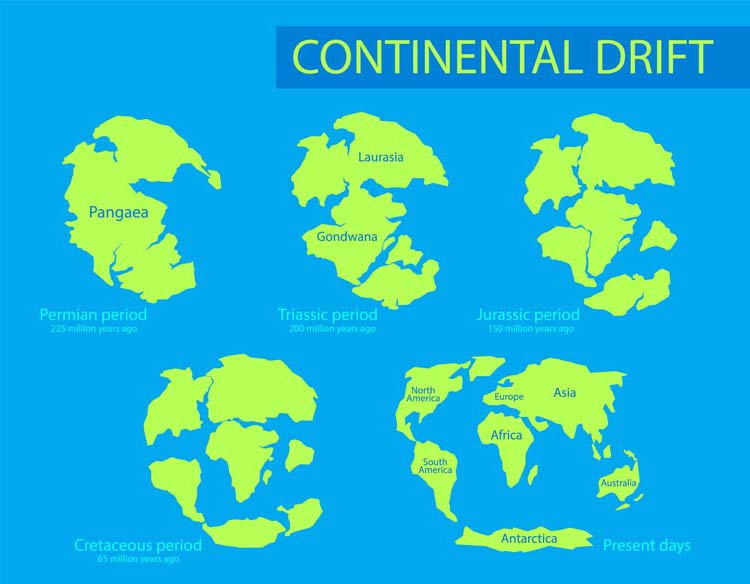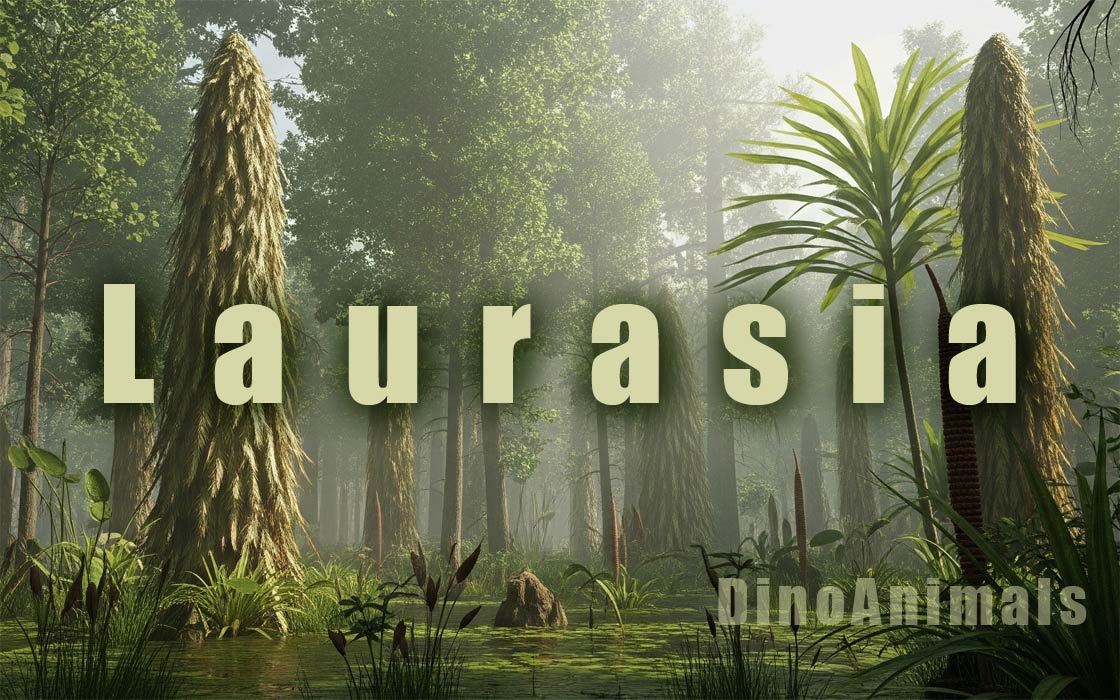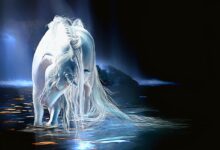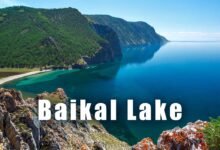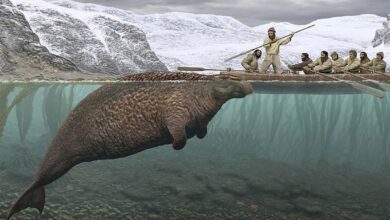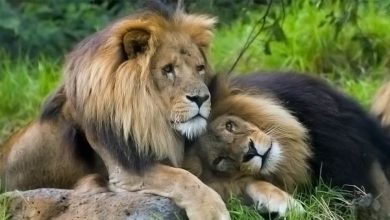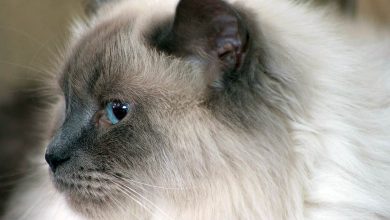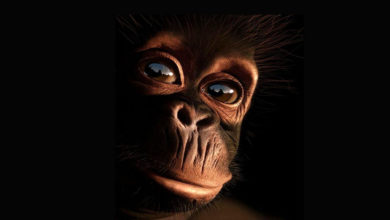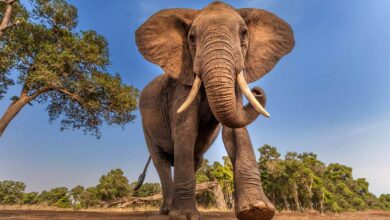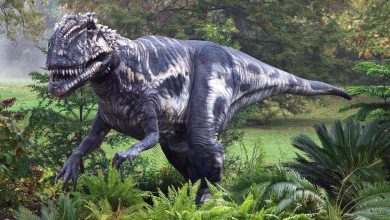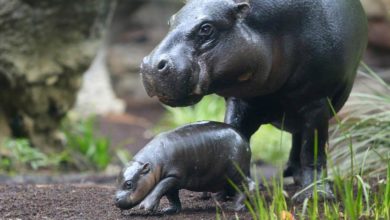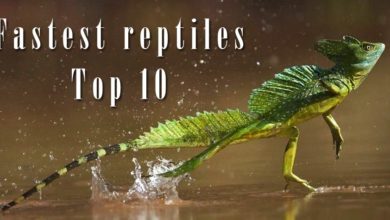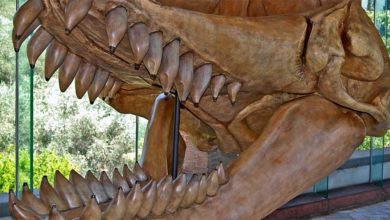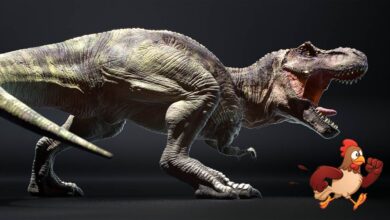Laurasia
Laurasia From Supercontinent to Today's Map. Remarkable History of Laurasia
Laurasia – The Forgotten Kingdom of the North
Imagine a world where traveling from present-day Europe to North America was possible without a ship or plane – on foot! While this sounds like a fantasy, millions of years ago such a journey was not only possible but real, all thanks to Laurasia. This gigantic landmass, once the northern part of the supercontinent Pangaea and later an independent landmass, played a crucial role in shaping the modern face of our planet. It was responsible for the distribution of the continents we live on today and had a massive impact on the evolution of countless species of plants and animals.
We will travel back in time to discover the history of Laurasia – from its formation from smaller continental blocks, through its heyday as the center of life in the Northern Hemisphere, to its gradual breakup, which gave rise to present-day North America, Europe, and most of Asia. We will explore its changing climate, lush flora, and extraordinary fauna, including the dominant dinosaurs, and learn how this ancient land still influences the world we know. Prepare for a geological tale of power and change that will forever alter your perception of the world map.
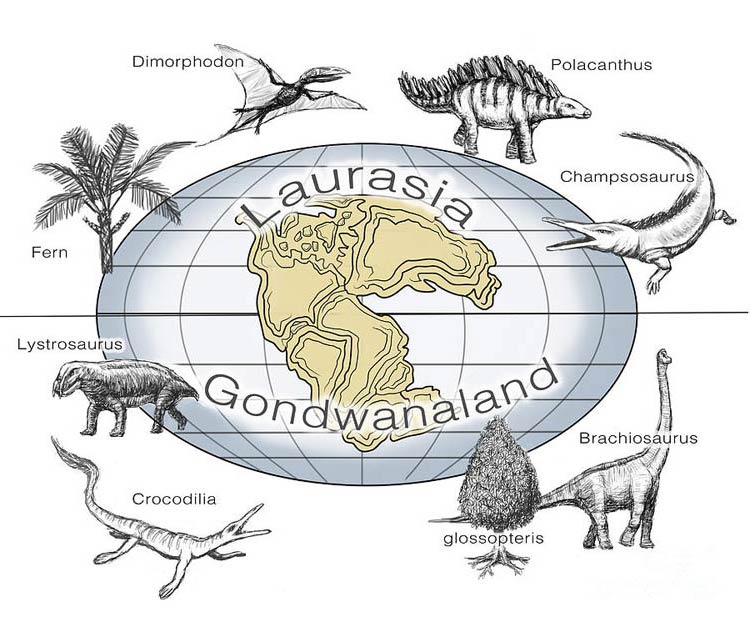
The Formation of Laurasia
The Origins of the Northern Landmass: How Did Laurasia Form?
The history of Laurasia is a tale of powerful natural forces that, over millions of years, shaped the Earth’s crust, joining and separating enormous landmasses. It didn’t form in an instant; its genesis was a complex process that began long before the formation of Pangaea.
Earlier Stages
Formation of Laurussia and Pangaea
The beginnings of Laurasia can be traced back to the Paleozoic Era, approximately 430-420 million years ago, when the collision of several smaller continents formed Laurussia (Euramerica). This was the result of the powerful Caledonian orogeny, which joined the ancient continents of Laurentia (present-day North America), Baltica (present-day Eastern and Northern Europe), and Avalonia (part of present-day Western Europe and the eastern coast of North America). This first significant continent was an important precursor to the future Laurasia.
Another crucial moment was the collision of Laurussia with the gigantic Gondwana in the late Carboniferous period. This monumental event, resulting from tectonic plate movements, led to the formation of Pangaea – the largest supercontinent in Earth’s history, which dominated the global map from the late Paleozoic to the early Mesozoic eras. Laurussia then became its northern part.
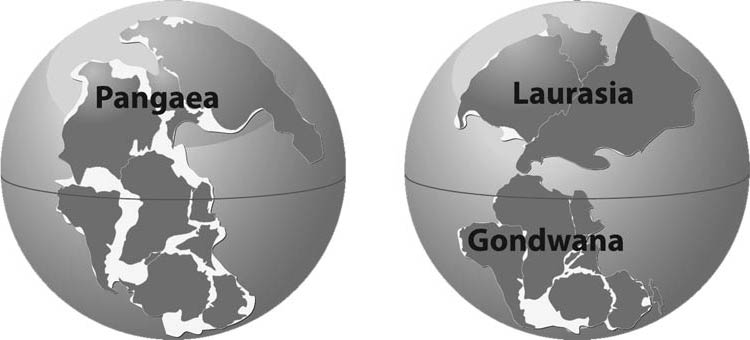
Emergence of Laurasia as an Independent Landmass
The Laurasia we know ultimately formed within Pangaea when additional landmasses: Kazakhstania and Siberia, joined the northern block. This occurred approximately 290-300 million years ago, at the end of the Paleozoic Era. Thus, Pangaea was clearly divided into two main parts: northern Laurasia and southern Gondwana.
However, the breakup of Pangaea proved crucial for Laurasia’s existence as an independent supercontinent. This process began approximately 215-175 million years ago, at the beginning of the Late Triassic period. Gigantic forces stretching the Earth’s crust led to fissures and the gradual separation of Laurasia from Gondwana. As a result of this rift, Laurasia became an independent, powerful continental mass, drifting in the Northern Hemisphere.
Geographic Components of Laurasia
Laurasia, as a distinct supercontinent, encompassed the areas we know today as:
- North America
- Europe (most of it, excluding some southern fragments)
- Asia (a significant portion, excluding the Indian subcontinent, which was part of Gondwana, and the Arabian Peninsula)
Understanding these early stages is crucial to comprehending how such an enormous geological structure could have formed and why it is so fundamentally important for the present-day distribution of landmasses on Earth.
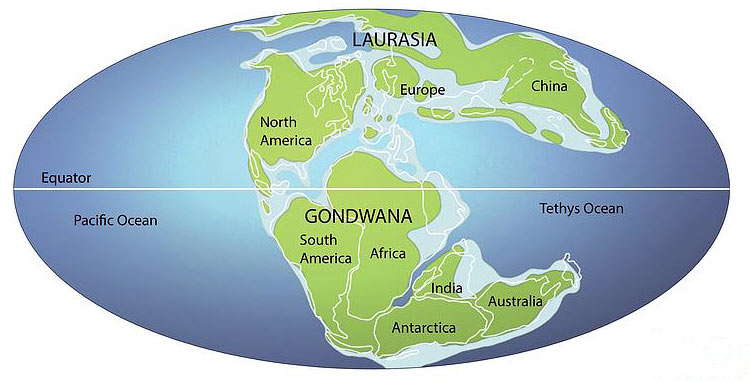
Laurasia as Part of Pangaea
Climate and Life Before the Breakup
Before Laurasia regained its independence, it spent a long period as the powerful northern part of the supercontinent Pangaea. This crucial stage in its history, lasting from approximately 335 to 175 million years ago (encompassing the Late Carboniferous, Permian, and Triassic periods), was fundamental for the evolution of life and the shaping of its future climate.
During this period, Pangaea stretched from pole to pole, which had a tremendous impact on global atmospheric and oceanic circulation. Laurasia, located primarily in the Northern Hemisphere, experienced highly varied climatic conditions.
Climate of Laurasia within Pangaea
Late Carboniferous
During this period, significant areas of Laurasia, particularly those closer to the equator (e.g., eastern North America and Europe), were characterized by a warm and humid climate. Extensive swamps and tropical rainforests fostered the intense development of vegetation, which ultimately led to the formation of the gigantic coal deposits we exploit today. Polar regions, such as Siberia, likely experienced colder conditions.
Permian
The Permian period brought a global cooling and drying trend. The interior of Pangaea, including Laurasia, became significantly drier, with deserts spreading across vast areas. This is typical for supercontinents, where massive landmasses hinder the penetration of moist air from the oceans. Distinct climatic zones emerged – from temperate in the north to arid in the central and southern parts of Laurasia.
Triassic
In the Triassic, the climate once again became warmer and more stable. Pangaea still existed, and Laurasia generally experienced hot and dry conditions across most of its area, although more humid regions appeared on its fringes, closer to the newly opening oceanic basins. The absence of large ice sheets at the poles (as in the Permian) and high levels of carbon dioxide in the atmosphere contributed to a greenhouse effect, which favored the development of reptilian life, including the first dinosaurs.
The immense size of Pangaea, and consequently Laurasia, blocked the flow of oceanic currents and created vast continental interiors that were not moderated by maritime influence. This resulted in extreme seasonal changes, with very hot summers and frigid winters, and monsoon rains may have been the only source of water across extensive territories.
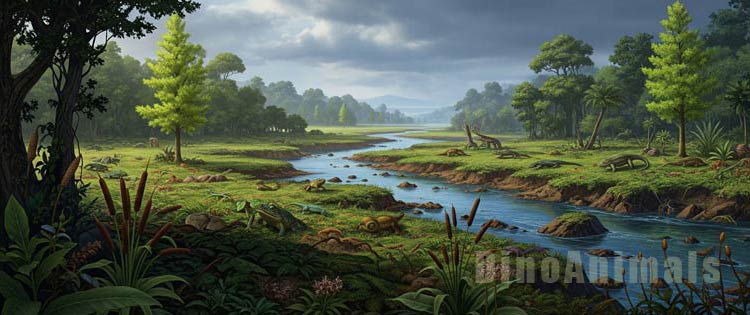
Flora of Laurasia
The Green Kingdom: Vegetation of the Laurasian Epoch
The vegetation of Laurasia, much like its climate, evolved and changed over millions of years, reflecting global geological and atmospheric transformations. From the humid swamps of the Carboniferous to the arid deserts of the Permian and the flourishing of gymnosperms in the Mesozoic, Laurasia’s flora witnessed and participated in extraordinary transitions.
Paleozoic Flora
Kingdom of Ferns and Early Seeds
In the Late Carboniferous, when Laurussia was already part of Pangaea, significant areas of Laurasia were characterized by a warm and exceptionally humid climate. These were ideal conditions for the development of lush, tropical rainforests, dominated by gigantic seed ferns, horsetails (such as Calamites, reaching tree-like heights), and tree lycopods (e.g., Lepidodendron and Sigillaria). These prehistoric plants formed dense, swampy forests that, after millions of years, fossilized, becoming the rich coal deposits exploited today in Europe and North America. It was during this time that Laurasia was truly a “coal factory.”
In the Permian, with the global cooling and drying of the climate, Laurasian vegetation had to adapt. The Carboniferous forests began to give way to more resilient formations. This period saw the development and dominance of gymnosperms, such as primitive conifers (e.g., Walchia) and the first ginkgoes. They were better adapted to drier conditions thanks to their needle-like leaves and the ability to produce seeds, which allowed them to survive unfavorable periods.
Mesozoic Flora
The Era of Gymnosperms
In the Triassic and Jurassic periods, when Laurasia was already a distinctly separate landmass (first as part of Pangaea, then independent), the climate was generally warm and often dry. Gymnosperms experienced their golden age. Laurasia’s forests were dominated by diverse conifers (ancestors of modern pines, spruces, and firs), cycads (resembling palms but botanically unrelated), and ginkgoes. Other groups of gymnosperms, such as Bennettitales, which resembled cycads in appearance, also spread. These plants formed the main food source for the increasing number of herbivorous dinosaurs.
In the Cretaceous period, just before Laurasia’s final breakup, one of the most significant events in floral history occurred – the appearance and rapid diversification of angiosperms (flowering plants). Initially small and inconspicuous, they quickly gained dominance, spreading across the entire continent. Their ability to reproduce quickly and adapt to diverse environments initiated an ecological revolution, influencing the evolution of insects and other animals.
The analysis of plant fossils from present-day North America, Europe, and Asia allows us to reconstruct the picture of Laurasia’s lush and diverse flora, which changed with continental movements and global climatic shifts.
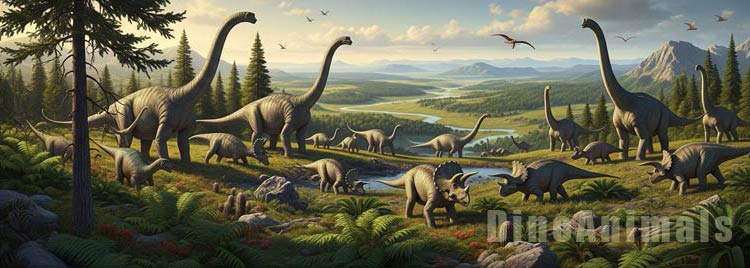
Fauna of Laurasia
Rulers of the Land: Animals That Inhabited Laurasia
The fauna of Laurasia is a story of evolution, adaptation, and dominance that unfolded on the northern landmasses of the supercontinent. From early tetrapods to gigantic dinosaurs, animal life in Laurasia was closely intertwined with its changing climate and geography, reflecting the unique conditions prevailing on this vast land.
Paleozoic Life
From Amphibians to Therapsids
In the Late Carboniferous, Laurasia’s humid and lush forests provided an ideal environment for early tetrapods. Alongside numerous species of amphibians, the first primitive reptiles also emerged here. Thanks to their ability to lay eggs on land, these reptiles could colonize drier areas. Both predatory and herbivorous forms, often heavily built, dominated this period.
In the Permian, as Laurasia’s climate became drier and more extreme, reptiles gained an advantage. Synapsids, the group of animals from which mammals later evolved, appeared on the scene. Among them, therapsids, often called “mammal-like reptiles,” were particularly prominent. These diverse creatures, ranging from herbivorous dicynodonts to predatory gorgonopsians, were the dominant terrestrial animals of Laurasia and Pangaea during this period, exhibiting many features that later became typical of mammals, such as differentiated dentition.
Mesozoic Fauna
The Age of Dinosaurs
The Triassic, Jurassic, and Cretaceous periods were times when Laurasia was home to some of the most iconic creatures in Earth’s history – dinosaurs. With the flourishing of gymnosperms, herbivorous dinosaurs found an abundant food source, which in turn fostered the development of powerful predators.
Dinosaurs of Laurasia
Groups typical of Laurasia included tyrannosaurs (their ancestors and early forms), long-necked sauropods (e.g., the famous Brachiosaurus or Diplodocus, although the latter also had close relatives in Gondwana), hadrosaurs (the “duck-billed” dinosaurs), and early forms of ceratopsians. The development of these groups often differed somewhat from those on the southern continent of Gondwana, leading to the emergence of unique evolutionary lineages. For example, Laurasia was dominated by theropods from the family Tyrannosauridae, while Abelisauridae developed in Gondwana.
Early Mammals
In the shadow of the dinosaurs, the first mammals developed in Laurasia. These were typically small, nocturnal creatures, often insectivorous, that managed to survive and evolve by exploiting ecological niches unavailable to the giant reptiles.
Other Reptiles
Besides dinosaurs, Laurasia was also inhabited by other reptiles. In the skies, pterosaurs – flying reptiles with membranous wings – reigned supreme, and in inland and coastal waters, crocodylomorphs, including aquatic and terrestrial forms, predominated.
Invertebrates
We must not forget the abundance of insects and arachnids, which played a crucial role in Laurasian ecosystems, pollinating plants and serving as food for smaller vertebrates.
The fauna of Laurasia testifies to life’s extraordinary ability to adapt. The geographical isolation that occurred with the breakup of Pangaea, and later Laurasia itself, fostered the emergence of distinct species and entire evolutionary lineages, whose traces we find in the fossil record on today’s northern continents.

The Breakup of Laurasia
The Great Rift: How Laurasia Divided into Continents
The breakup of Laurasia was a process spanning tens of millions of years, initiated by powerful geological forces within the Earth’s interior. This monumental process of plate tectonics led to the formation of the continents we know today in the Northern Hemisphere.
Causes of the Breakup
The primary cause of Laurasia’s breakup, much like Pangaea’s earlier fragmentation, was convection currents in the Earth’s mantle. These slow but relentless movements of hot magma beneath the continental crust generated immense stresses. In areas where tectonic plates stretched (known as rift zones), the Earth’s crust thinned, leading to cracking and the formation of rift valleys, and consequently – the separation of continental blocks. This process was often associated with intense volcanic activity.
Stages of Breakup
The breakup of Laurasia was a complex process that occurred in several main stages:
Northward Drift
After separating from Gondwana in the Late Triassic (approximately 215-175 million years ago), Laurasia, as a single, massive continental plate, began to drift northward. This movement gradually carried it away from the equator, influencing global climate patterns.
Opening of the North Atlantic
The most significant and spectacular event in Laurasia’s breakup was the opening of the Atlantic Ocean. This process began around 180 million years ago (in the Jurassic period), when the first rifts started forming between present-day North America and Europe (part of Eurasia). Initially, narrow oceanic basins formed, which gradually widened over time. The fully developed North Atlantic began to clearly separate these landmasses approximately 56 million years ago, during the Paleogene period. The formation of the Mid-Atlantic Ridge, where magma continuously rises to the surface, is direct evidence of this ongoing plate separation.
Separation of Europe from Asia and the Formation of the Arctic Ocean
Parallel to the opening of the Atlantic, internal forces continued to tear Laurasia apart in the east. This process led to the gradual separation of the North American plate from the Eurasian plate, as well as further movements within Eurasia itself, which resulted in the formation of the Arctic Ocean. The European and Asian continents, though still connected, began to take on their modern shapes.
Timeline
The main phases of Laurasia’s breakup, which led to its ultimate division into today’s continents, primarily occurred during the Cretaceous and Paleogene periods, from approximately 66 to 30 million years ago. It was then that North America separated from Europe, and tectonic processes shaped the current boundaries of the landmasses in the Northern Hemisphere.
The breakup of Laurasia was not a sudden event, but rather a prolonged and dynamic process that forever changed Earth’s geography, opening new oceans and creating geographical barriers which, in turn, influenced the further evolution of life.
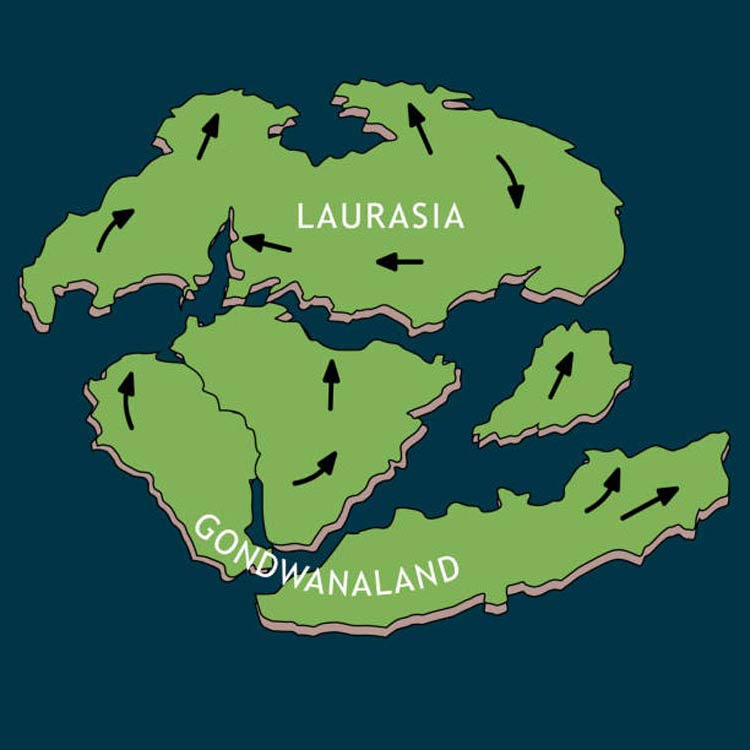
The Impact of Laurasia on Earth
Echoes of the Past: Laurasia’s Long-Term Influence on Earth
The existence and breakup of Laurasia had a gigantic impact on our planet, shaping both the climate and the evolution of life.
Climate and Oceans
When Laurasia was part of the supercontinent Pangaea, it blocked the flow of oceanic currents, leading to extreme climates in its interior. Its breakup opened new oceans, such as the Atlantic, enabling ocean currents to transport heat and significantly moderating the global climate. This initiated today’s climatic zones and increased humidity in many regions.
Evolution of Life and Biogeography
The breakup of Laurasia was crucial for the evolution of life in the Northern Hemisphere. The division of land isolated populations, leading to speciation and the emergence of new species. Dinosaurs are an excellent example – unique groups developed in Laurasia (e.g., ancestors of tyrannosaurs), distinct from those in Gondwana. Today’s similarities in the fauna and flora of North America, Europe, and East Asia (e.g., due to the ancient Beringia) bear witness to these prehistoric connections.
Geological Evidence
The existence and breakup of Laurasia are confirmed by tangible geological evidence:
- Fit of the coastlines of continents on both sides of the Atlantic.
- Similarity of rock formations and mountain ranges (e.g., the Appalachians and the Caledonides) on continents now separated by an ocean.
- Occurrence of the same fossils on landmasses that are distant today.
Laurasia’s influence is ubiquitous, helping us understand Earth’s dynamics and the processes that have shaped life over eons.
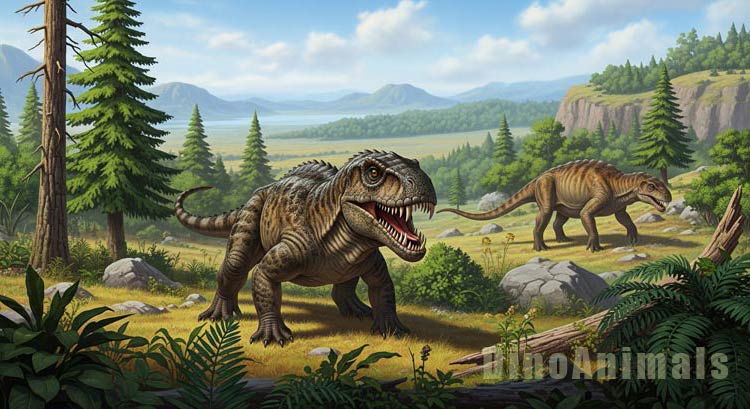
Detailed Data
Laurasia
To fully appreciate the scale and significance of Laurasia, it is worth examining specific chronological, geographical, and geological data that precisely outline its history and the traces it left behind.
Chronology of Key Events
The history of Laurasia encompasses millions of years of geological processes. Here are the most important stages and their timeframes:
- ~430-420 million years ago (Late Silurian – Early Devonian): Formation of Laurussia (Euramerica) as a result of the Caledonian orogeny, joining Laurentia, Baltica, and Avalonia.
- ~335 million years ago (Late Carboniferous): Collision of Laurussia with Gondwana and the formation of Pangaea. Laurasia becomes the northern part of the new supercontinent.
- ~290-300 million years ago (Late Permian – Early Triassic): Integration of Kazakhstania and Siberia into the northern block, solidifying Laurasia’s position as a distinct part of Pangaea.
- ~215-175 million years ago (Late Triassic – Early Jurassic): Beginning of the breakup of Pangaea and the separation of Laurasia from Gondwana, making it an independent supercontinent.
- ~180 million years ago (Jurassic): Beginning of the opening of the Atlantic Ocean between North America and Europe/Africa.
- ~66 million years ago (end of the Cretaceous): Beginning of the intensive breakup of Laurasia into North America and Eurasia.
- ~56 million years ago (Paleocene): Significant opening of the North Atlantic, separating North America from Europe.
- ~30 million years ago (Oligocene): Final stages of the formation of Laurasia’s present-day continental shapes, including further expansion of the Atlantic and the shaping of the Arctic Ocean.
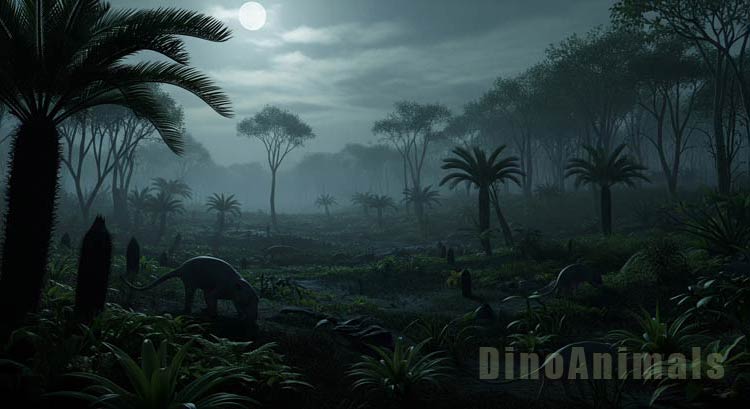
Estimated Dimensions
In its heyday, as a unified landmass, Laurasia occupied vast areas of the Northern Hemisphere. Its surface area was comparable to the sum of the surface areas of the present-day continents that originated from it, namely North America, Europe, and most of Asia. Precise estimations are difficult, but we can speak of tens of millions of square kilometers (or square miles), which made it one of the largest landmasses in Earth’s history, rivaling the scale of today’s Eurasia and North America combined.
Rock Types and Geological Formations
Various geological formations, testifying to its turbulent history, occurred and still occur within Laurasia:
- Mountain Ranges Powerful mountain ranges formed as a result of the collision of continents that led to the creation of Laurussia and Laurasia. Examples include:
- The Appalachian Mountains in North America and the Caledonides in Europe (including the Scandinavian Mountains, the Scottish Highlands, and partly in Poland), which are remnants of the Caledonian orogeny.
- The Ural Mountains in Russia, which are a trace of the collision between Siberia and Laurussia.
- Coal Basins Rich deposits of hard coal (bituminous coal) in North America (e.g., the Appalachian Coal Basin) and Europe (e.g., the Upper Silesian Coal Basin) are a direct legacy of the lush swamp vegetation from the Carboniferous period that grew on Laurasia.
- Deserts and Eolianites Desert areas from the Permian period left behind characteristic sandstone rocks, often reddish in color, formed by wind (eolianites).
- Rift Valleys Remnants of the early stages of the breakup of Pangaea and Laurasia can be found in the form of old, sediment-filled rift valleys on both sides of the present-day Atlantic.
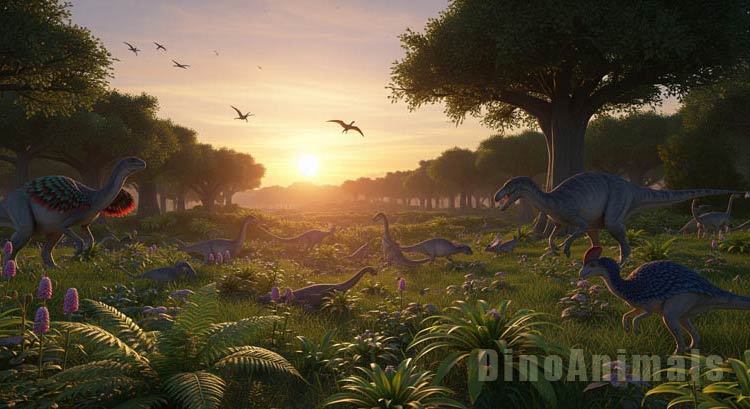
Laurasia – Interesting Facts
The history of Laurasia, though distant, still resonates in the modern world, offering intriguing insights and surprising connections.
- Laurasia and the Theory of Continental Drift
The existence of supercontinents, such as Laurasia and Pangaea, provided crucial evidence supporting the groundbreaking theory of continental drift, proposed by Alfred Wegener. The excellent fit of the coastlines of North America and Europe, as well as identical geological formations and fossil similarities on both sides of the Atlantic, provided undeniable arguments that helped science reconstruct the prehistoric positions of the landmasses. - Paleobiogeographical Connections
The breakup of Laurasia explains many mysteries in paleobiogeography. For instance, why do many plant and animal species in present-day North America have close relatives in East Asia, but not necessarily in Europe? The answer lies in the fact that after North America separated from Europe, a land connection between North America and Asia via the area of present-day Beringia (now the Bering Strait) persisted much longer. This Bering land bridge allowed for the free exchange of species for millions of years, even as the Atlantic widened. - Differences in Dinosaur Evolution
The separation of Laurasia and Gondwana led to divergent evolution of dinosaurs on the two continents. In Laurasia, iconic groups such as the ancestors of tyrannosaurs and early ceratopsians Meanwhile, Gondwana was dominated by other types of large predatory theropods (like abelisaurids) and gigantic titanosaur sauropods. - Laurasia as a “Coal Factory”
The humid and lush climate of the Late Carboniferous in Laurasia, particularly in regions of present-day North America and Europe, favored the formation of extensive swamp forests. Their remains, subjected to geological processes over millions of years, became gigantic deposits of bituminous coal (hard coal), which are exploited to this day and serve as important evidence of the supercontinent’s prehistoric environments.

Podcast: Laurasia – The Forgotten Kingdom of the North
Tune into our podcast, where we present the history of the formation, development, and breakup of Laurasia – the northern continent that, along with Gondwana, formed the supercontinent Pangaea.
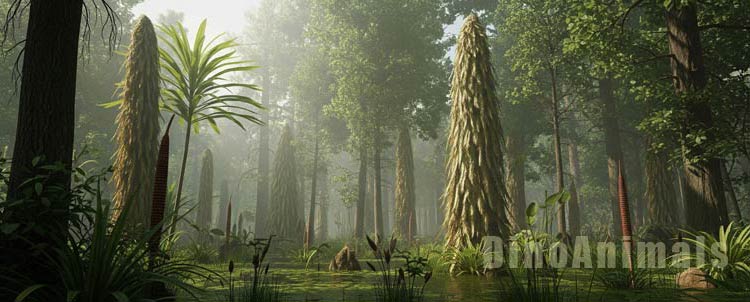
Glossary of Terms
Explanation of key names and concepts used in the article:
- Avalonia – An ancient continent that, in the Paleozoic Era, merged with Laurentia and Baltica to form Laurussia (Euramerica). Today, its fragments constitute parts of Western Europe and the eastern coast of North America.
- Baltica – An ancient continent, now forming, among others, Eastern and Northern Europe. In the Paleozoic Era, it merged with Laurentia and Avalonia to form Laurussia (Euramerica).
- Beringia – A prehistoric land bridge that repeatedly connected Asia (Siberia) with North America (Alaska) during periods of lowered sea level. It facilitated the migration of species between continents.
- Ceratopsians – A group of herbivorous dinosaurs characterized by a beak, a bony frill on the neck, and often horns (e.g., Triceratops). Early forms developed in Laurasia.
- Tetrapods – In the broadest sense, all terrestrial vertebrates possessing four limbs (or descended from such ancestors), including amphibians, reptiles, birds, and mammals.
- Continental Drift – A hypothesis (now part of the broader theory of plate tectonics) stating that continents move horizontally across the Earth’s surface over geological time.
- Euramerica (Laurussia) – A continent formed in the Paleozoic Era from the collision of Laurentia, Baltica, and Avalonia. It was the precursor to the later Laurasia.
- Gondwana – A vast southern supercontinent that existed from the Neoproterozoic to the Jurassic period. It formed from the amalgamation of landmasses that today constitute South America, Africa, Antarctica, Australia, and the Indian Subcontinent.
- Hadrosaurs – A family of herbivorous ornithischian dinosaurs, often called “duck-billed dinosaurs” due to the shape of their snouts. They were present in Laurasia.
- Conifers – A group of gymnosperm plants most commonly characterized by needle-shaped or scale-like leaves (e.g., pines, spruces). They dominated Laurasia during the Mesozoic Era.
- Geographic Isolation – The process of separating species populations by geographical barriers (e.g., oceans, mountains), leading to independent evolution and speciation.
- Carboniferous – A period in the Paleozoic Era (approx. 359-299 million years ago), characterized by lush vegetation and the formation of extensive coal deposits.
- Cretaceous – The last period in the Mesozoic Era (approx. 145-66 million years ago), marking the end of the age of dinosaurs and the flourishing of angiosperms.
- Laurasia – The northern supercontinent that existed during the Mesozoic Era. It formed from the breakup of Pangaea and encompassed the areas of present-day North America, Europe, and most of Asia.
- Laurentia – An ancient continent that, in the Paleozoic Era, became the core of present-day North America. It was a key component of Laurussia.
- Mesozoic – An era in Earth’s history (approx. 252-66 million years ago), known as the Age of Dinosaurs, divided into the Triassic, Jurassic, and Cretaceous periods.
- Gymnosperms – A group of plants (e.g., conifers, cycads, ginkgoes) characterized by their seeds not being enclosed within an ovary. They dominated the Mesozoic Era.
- Caledonian Orogeny – A cycle of mountain building and folding (orogeny) that occurred during the Paleozoic Era (mainly Silurian and Devonian) and led to the formation of Laurussia.
- Paleozoic – An era in Earth’s history (approx. 541-252 million years ago) during which multicellular life, fish, amphibians, reptiles, and the first land plants developed.
- Pangaea – A supercontinent that existed from the Late Paleozoic to the Early Mesozoic (approx. 335-175 million years ago), combining nearly all of Earth’s landmasses.
- Permian – The last period in the Paleozoic Era (approx. 299-252 million years ago), characterized by an arid climate and the dominance of reptiles, ending with the largest mass extinction in Earth’s history.
- Pterosaurs – Flying reptiles that dominated the skies during the Mesozoic Era. They were not dinosaurs but coexisted with them.
- Cycads – A group of gymnosperm plants resembling palms but botanically unrelated to them. They were common in Laurasia during the Mesozoic Era.
- Speciation – The evolutionary process by which new, distinct species arise from a single population.
- Synapsids – A group of vertebrates that includes mammals and all extinct forms more closely related to mammals than to reptiles. They dominated in the Permian period.
- Therapsids – A subgroup of synapsids, often called “mammal-like reptiles,” which dominated in the Permian period and were the ancestors of mammals.
- Plate Tectonics – A scientific theory explaining the movements of the Earth’s lithosphere (tectonic plates) and associated geological phenomena, such as earthquakes, volcanoes, and mountain formation.
- Triassic – The first period in the Mesozoic Era (approx. 252-201 million years ago), during which the first dinosaurs and mammals appeared.
- Tyrannosaurs – A family of large, predatory theropod dinosaurs, such as the famous Tyrannosaurus rex. They were present in Laurasia.
- Tree Lycopods – Extinct forms of plants from the clubmoss group, which reached tree size in the Carboniferous period and were dominant components of Laurasia’s coal-forming forests (e.g., Lepidodendron, Sigillaria).
- Sauropods – A group of herbivorous dinosaurs characterized by a long neck and tail, and four powerful legs (e.g., Brachiosaurus, Diplodocus).
